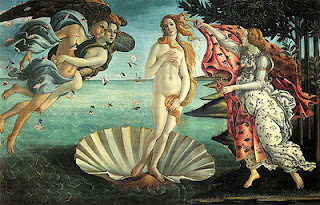This painting is called Art and Literature:
 |
| L'art et la litterature, William-Adolphe Bouguereau, 1867, Oil on canvas, 78-3/4 x 42-1/2" (Art and Literature, c. 1867, Oil on Canvas, William-Adolphe Bouguereau, Arnot Art Museum Elmira) |
The Birth of Venus shows Bouguereau's exceptional grasp of form and skill in painting the human form, particularly the female human body. The idealized world of mythology, gods, goddesses, nymphs, and legends is were Bouguereau prevailed in the accurate details, beautiful renderings of flesh, and symbolism.
To compare this with a classical masterpiece below is Botticelli's Birth of Venus, 1486 nearly 400 years earlier
 |
| Birth of Venus, c. 1486, Tempera on Canvas, Sandro Botticelli, Uffizi Gallery, Florence |
Botticelli, displays all the symbolism, iconography, and mythology in his painting present in Bouguereau's painting, but Bouguereau brings in an element of a more 'real' female heroine with the realistic flesh and form of Venus. She is painted in a manner appearing perfect yet she could be real unlike Botticelli's who still appears as if only a dream.


No comments:
Post a Comment